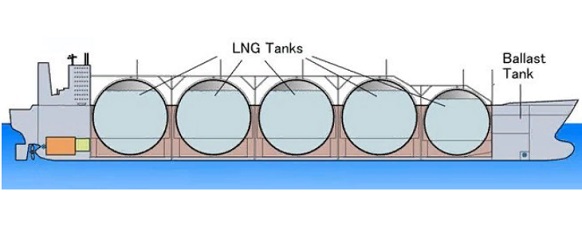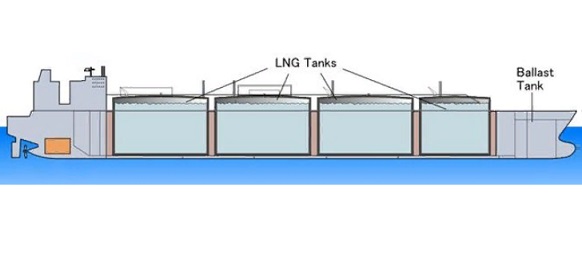- for energy purposes (petroleum gases, natural gases),
- in the chemical industry (ethylene, vinyl chloride, propylene, etc.);
- as a raw material for making agricultural fertiliser (ammonia).
The design and operation of liquefied gas carriers is principally governed by the International Gas Carrier Code (IGC Code).
The movement of liquefied gases by waterways is now a mature industry, served by a fleet of many tankers, a network of export and import terminals and a wealth of knowledge and experience on the part of various people involved.
Gas carriers have certain features common with other tankers used for the carriage of bulk liquids such as oil and chemical tankers.
A feature almost unique to the gas carrier is that the cargo is kept under positive pressure to prevent air entering the cargo system.
This means that only cargo liquid and cargo vapour are present in the cargo tank and flammable atmospheres cannot develop.
A modern typical gas carrier (LNG tanker, methane carrier) has a carrying capacity of 155-220 thousand m3 of liquefied natural gas (LNG), from which about 95 - 135 million m3 of natural gas can be obtained as a result of regasification.
Like tea clippers in their time, gas carriers are a privileged, high-speed class of hydrocarbon tankers.
If the speed of an oil tanker is about 14 knots, then a gas carrier is up to 20 knots (not in ice conditions, of course).
Loading and unloading of gas carriers is complex, but unified and takes relatively little time, on average 12-18 hours.
In case of an accident, LNG tankers have a 2-hull structure to prevent leaks and ruptures.
LNG is transported at atmospheric pressure, at a temperature of -162 ° C in special insulated tanks (tanks) inside the inner hull of a LNG carrier.
Equipped with refrigeration units for gas cooling.
An LNG storage system consists of a storage tank or storage tank, an insulation layer, a secondary containment to prevent leaks, and another layer of insulation.
If the primary tank is damaged, the secondary containment will prevent leakage.
All surfaces in contact with LNG are made of materials that are resistant to extremely low temperatures.
In tankers built using Gas Transport (GT) technology, tanks are made of 0.5 mm invar steel (FeNi36) with pearlite insulation, and using Technik Gas (TG) technology - from corrugated stainless steel 1.2 mm with PVC block insulation.

The most widespread are tankers with MOSS-type tanks, which now make up 41% of the world methane carrier fleet.
The shipbuilding company Kvaerner Masa-Yards, which started production of Moss-type gas tankers, borrowed the idea of self-supporting spherical tanks from tankers carrying petroleum gases (APG).
The reasons for this popularity are self-sustaining cheap isolation and construction of tanks separately from the gas tanker with subsequent attachment to the ship's hull using a cuff along the equator of the tank.
Taken together, this significantly improves economic performance and makes it nearly 25% more economical.
The disadvantage of a spherical tank is the need to cool a large mass of aluminum.
Moss Maritime has proposed replacing the internal insulation of the tank with polyurethane foam, but this has not yet been implemented.
The new generation of gas tankers made it possible to increase the cargo space with the help of spherical tanks, not to burn off boil-off gas, but to liquefy it using a compact gas tanker and significantly save marine fuel using a diesel-electric installation.

Until the end of 1990, the MOSS design dominated, but in recent years, due to price changes, almost 2/3 of ordered LNG carriers have membrane tanks that are much lighter than spherical ones.
Membrane tanks are built only after the gas tanker is launched into the water.
This is a rather expensive technology with a long construction time of up to 1.5 years.
In addition to gas storage tanks, the tankers are equipped with gas-fired refrigeration units for cooling LNG.
The main tasks of shipbuilding today are to increase the cargo capacity with unchanged hull dimensions and reduce the cost of insulation.
In addition to the spherical type MOSS tank, these requirements are met by 3 main types of 3-membrane cargo tanks used on 57% of LNG carriers:
GazTransport system includes primary and secondary membranes in the form of flat panels of Invar steel.
In the Technikgaz system, the primary diaphragm is made of corrugated stainless steel.
In the CS1 system, invar panels from the GazTransport system, acting as a primary membrane, are combined with Technikgaz 3-layer membranes (aluminum sheet placed between 2 layers of fiberglass) as secondary insulation.
Unlike LPG (liquefied petroleum gas) vessels, LNG carriers are not equipped with a deck liquefaction unit.
Previously, flared boil-off gas (BOG) cost shipowners free of charge, since, due to the lack of a boil-off gas liquefaction unit (BOG), it could not be utilized and had to be released into the atmosphere.
Currently, gas tankers are equipped with 2-fuel steam turbines capable of operating on both marine fuel oil and boil-off gas.
The maximum permissible value of the evaporation rate in a fluidized bed is about 0.15% / day of the cargo volume.
Despite the higher cargo capacity of up to 250 thousand m3, the shipbuilders managed to keep the draft of 12 meters for the new LNG tankers, as well as for the tankers with a gas oil of 140 thousand m3.
This is convenient when passing, for example, the Suez Canal and when docking to most LNG terminals.
However, their body will be wider and longer.If the primary tank is damaged, the secondary containment will prevent leakage.
All surfaces in contact with LNG are made of materials that are resistant to extremely low temperatures.
In tankers built using Gas Transport (GT) technology, tanks are made of 0.5 mm invar steel (FeNi36) with pearlite insulation, and using Technik Gas (TG) technology - from corrugated stainless steel 1.2 mm with PVC block insulation.

The most widespread are tankers with MOSS-type tanks, which now make up 41% of the world methane carrier fleet.
The shipbuilding company Kvaerner Masa-Yards, which started production of Moss-type gas tankers, borrowed the idea of self-supporting spherical tanks from tankers carrying petroleum gases (APG).
The reasons for this popularity are self-sustaining cheap isolation and construction of tanks separately from the gas tanker with subsequent attachment to the ship's hull using a cuff along the equator of the tank.
Taken together, this significantly improves economic performance and makes it nearly 25% more economical.
The disadvantage of a spherical tank is the need to cool a large mass of aluminum.
Moss Maritime has proposed replacing the internal insulation of the tank with polyurethane foam, but this has not yet been implemented.
The new generation of gas tankers made it possible to increase the cargo space with the help of spherical tanks, not to burn off boil-off gas, but to liquefy it using a compact gas tanker and significantly save marine fuel using a diesel-electric installation.

Until the end of 1990, the MOSS design dominated, but in recent years, due to price changes, almost 2/3 of ordered LNG carriers have membrane tanks that are much lighter than spherical ones.
Membrane tanks are built only after the gas tanker is launched into the water.
This is a rather expensive technology with a long construction time of up to 1.5 years.
In addition to gas storage tanks, the tankers are equipped with gas-fired refrigeration units for cooling LNG.
The main tasks of shipbuilding today are to increase the cargo capacity with unchanged hull dimensions and reduce the cost of insulation.
In addition to the spherical type MOSS tank, these requirements are met by 3 main types of 3-membrane cargo tanks used on 57% of LNG carriers:
- membrane type of system "Gas Transport No. 96" (GT);
- membrane tank of the Technikgas Mark III (TG) system;
- the CS-1 system is being introduced, which is a combination of the above membrane systems.
GazTransport system includes primary and secondary membranes in the form of flat panels of Invar steel.
In the Technikgaz system, the primary diaphragm is made of corrugated stainless steel.
In the CS1 system, invar panels from the GazTransport system, acting as a primary membrane, are combined with Technikgaz 3-layer membranes (aluminum sheet placed between 2 layers of fiberglass) as secondary insulation.
Unlike LPG (liquefied petroleum gas) vessels, LNG carriers are not equipped with a deck liquefaction unit.
Previously, flared boil-off gas (BOG) cost shipowners free of charge, since, due to the lack of a boil-off gas liquefaction unit (BOG), it could not be utilized and had to be released into the atmosphere.
Currently, gas tankers are equipped with 2-fuel steam turbines capable of operating on both marine fuel oil and boil-off gas.
The maximum permissible value of the evaporation rate in a fluidized bed is about 0.15% / day of the cargo volume.
Despite the higher cargo capacity of up to 250 thousand m3, the shipbuilders managed to keep the draft of 12 meters for the new LNG tankers, as well as for the tankers with a gas oil of 140 thousand m3.
This is convenient when passing, for example, the Suez Canal and when docking to most LNG terminals.
A more powerful 2-fuel gas-oil diesel engine will be used as a propulsion system.
Gas carrier types
Gases can be liquefied by using one of the following methods:
- pressurization under normal temperature. Ships that carry gas products under this metod are referred to as «fully pressurized gas carriers»;
- refrigeration and pressurization. Ships that carry gas products under this metod are referred to as «semi-refrigerated gas carriers»;
- refrigeration under atmospheric temperature. This ships are called «refrigerated gas carriers» and this type is often used in design of large LPG ore LNG carriers.
Pressure gas carriers, also fully-pressurized ships:
- are the simplest of all gas carriers in terms of containment systems and cargo-handling equipment and carry their cargoes at ambient temperature;
- independent pressure vessels with a typical design vapour pressure of 17.5 bar are used as cargo tanks (type C tanks). Ships with higher design vapour pressure are in service; 18 bar is quite common - a few ships can accept pressure up to 20 bar;
- no thermal insulation or a reliquefaction plant is necessary and cargo can be discharged by either pumps or compressors;
- because of their design pressure the tanks are extremely heavy. As a result, fully pressurised ships tend to be small with maximum cargo capacities of about 4000 m3 and they are used to carry primarily LPG and ammonia.
Semi-refrigerated gas carriers:
- сonstructed in the size range of 1500 - 30,000 m3, this type of gas carrier evolved as the optimum means of transporting the variety of gases, from LPG and VCM to propylene and butadiene;
- is the most popular amongst operators of «smaller-size» gas carriers;
- use pressure vessel tanks designed for design vapour pressure in the range of 4-8 bar. The tanks are made either from low temperature steels for carriage temperature of -48°C which is suitable for most LPG and chemical gas cargoes, or from special alloyed steels to allow the carriage of ethylene at -104°C.
Fully-refrigerated gas carriers:
- can carry cargoes at approximately atmospheric pressure and are generally designed to transport large quantities of LPG and ammonia;
- have been used different cargo containment systems. The most widely used arrangement is the independent tanks with single side shell. Type A prismatic freestanding tanks capable of withstanding a maximum design vapour pressure of 0.7 bar are used. A complete secondary barrier is required and the hold spaces must be inerted when carrying flammable cargoes.
The consumption of LNG is increasing across the world.
Often, new gas projects are far from consumers.
Therefore, the demand for new gas carriers with a larger capacity, capable of carrying up to 2,30,000 m3, has grown.
Ship-shore compatibility has become a major issue for many existing import LNG terminals.


